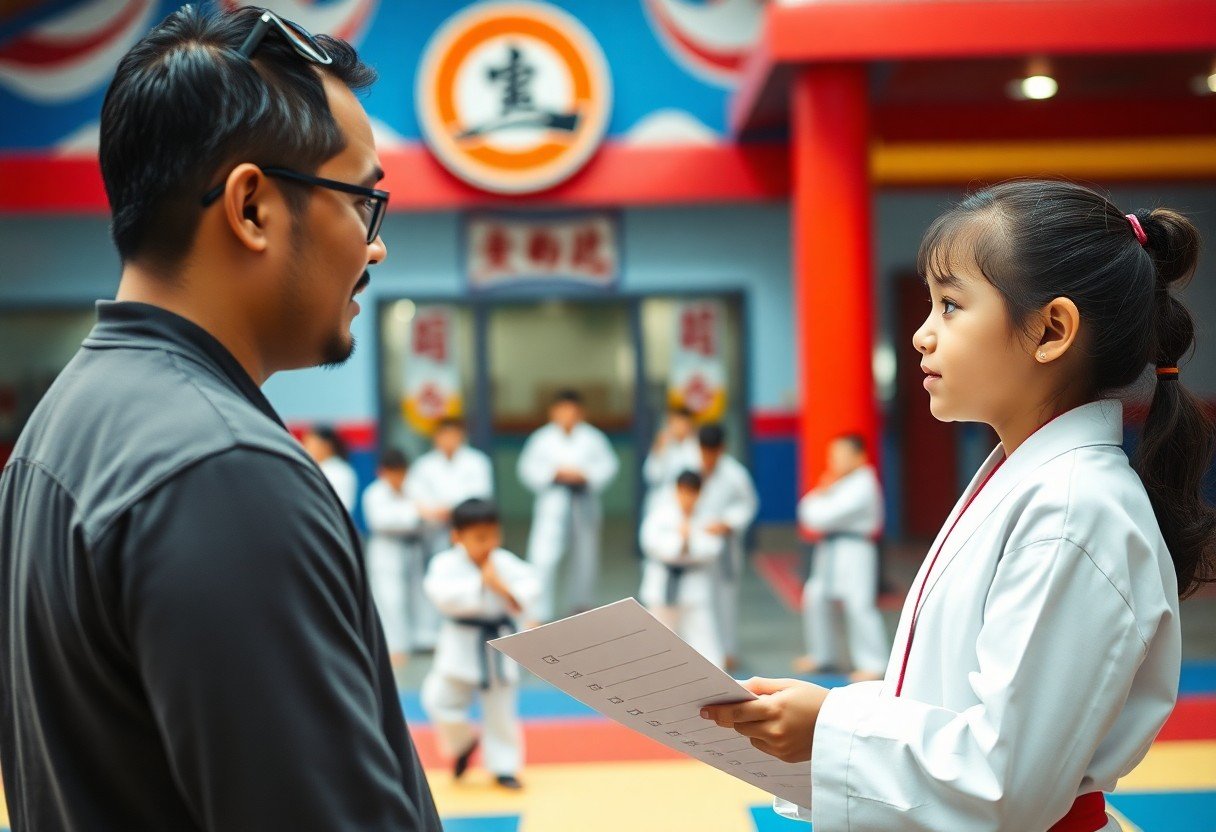Many parents face the challenge of selecting the best martial arts school for their child, a decision that can greatly influence their development. To ensure a positive experience, you should consider factors such as instructor credentials, class sizes, and the school’s philosophy. Assessing these elements will help you find an environment that promotes both safety and personal growth for your child, ultimately fostering their confidence and discipline in a supportive community.
Understanding Your Child’s Interests
Before selecting a martial arts school, explore into your child’s interests and preferences. Engage them in discussions about martial arts and what aspects excite them, whether it’s the discipline, self-defence skills, or the opportunity to make new friends. Tailoring your approach based on their enthusiasm will ensure they are more likely to commit and enjoy their journey in martial arts.
Assessing Physical Fitness and Energy Levels
Behind every successful martial arts training experience is an understanding of your child’s physical fitness and energy levels. Observing how they engage in physical activities can give you insights into their stamina and enthusiasm for movement. This enables you to select a school that matches their current abilities and encourages growth.
Identifying Goals for Martial Arts Training
Physical goals guide your child’s journey in martial arts. Consider whether they seek to develop self-discipline, learn effective self-defence, improve their fitness, or simply enjoy a fun activity. Establishing clear objectives helps you find a school that aligns its curriculum with these aspirations, ensuring a fulfilling and motivating experience.
Plus, having defined goals can greatly enhance your child’s martial arts experience. It allows them to concentrate on specific skills and achievements, enhancing their motivation and sense of purpose. Discussing their ambitions can also solidify commitment, as they will see both immediate progress and long-term benefits in areas like confidence and focus. Furthermore, aligning their goals with the school’s philosophy ensures they derive the greatest satisfaction from their training.
Researching Different Martial Arts Styles
Even with numerous martial arts styles available, it’s imperative to understand their distinct characteristics before making a choice. Each discipline varies in focus, techniques, and philosophies, which can significantly impact your child’s training experience. Researching these styles allows you to find the right fit that resonates with your child’s interests and goals, ensuring they enjoy their journey into martial arts.
Overview of Popular Martial Arts
Beside the traditional karate and judo, many other styles such as taekwondo, Brazilian jiu-jitsu, and muay Thai offer unique benefits. Each martial art emphasises different aspects like striking, grappling, or self-defence techniques, allowing you to assess which aligns best with your child’s interests. Understanding these variations can guide you towards a school that teaches a style your child will be excited to learn.
Matching Styles to Your Child’s Personality
Personality plays a significant role in determining the right martial arts style for your child. If they are high-energy and competitive, styles such as taekwondo or kickboxing may be ideal, as these can channel their enthusiasm positively. Alternatively, more disciplined practitioners may thrive in karate or judo, where focused training and respect are emphasised.
Martial arts offer a range of styles suited to different personality traits, hence understanding your child’s emotional inclinations and physical capabilities is vital. For example, children who may be shy or prefer a slower pace might excel in tai chi, which emphasises control, mindfulness, and inner peace. On the other hand, if your child enjoys vigorous activity and teamwork, then capoeira could provide an exciting blend of dance and martial arts. Identifying these traits will ensure the style matches their personality, fostering both growth and enjoyment.
Evaluating Schools and Instructors
Some factors to consider when evaluating martial arts schools include the curriculum offered, class sizes, and instructor teaching styles. Visiting a few schools will give you an idea of their atmosphere and the quality of instruction. You can also find helpful tips in this guide on How To Pick A Martial Arts Class For Your Kid.
Credentials and Experience of Instructors
After identifying potential schools, you should look into the credentials and experience of the instructors. Ensure they hold qualifications from recognised organisations and have relevant experience in teaching children. Instructors who are passionate and patient can greatly enhance your child’s learning journey.
School Environment and Culture
On top of the quality of instruction, the school’s environment and culture play a vital role in your child’s martial arts experience. A welcoming and inclusive atmosphere can make all the difference in encouraging your child to participate and grow.
Schools that foster a strong sense of community often provide a positive learning environment, where your child feels safe and supported. Look for a place where respect, discipline, and camaraderie are emphasised. It’s also imperative to ensure that the school’s culture aligns with your values. A negative atmosphere can lead to disengagement or even instances of bullying, so be vigilant about the interaction between students and instructors. The right environment can significantly impact your child’s confidence and enjoyment in training.
Observing Classes
Keep your eyes peeled during observation sessions. It’s important to watch not only the teaching style but also the interaction between the instructor and the students. Look for a positive and encouraging environment that motivates children and fosters respect. Additionally, take note of how discipline is enforced and whether or not students show enthusiasm and engagement in their practice.
What to Look For During a Trial Class
Any instructor should display a clear understanding of child development and be able to communicate effectively with younger students. Notice whether they can maintain order while making the class enjoyable. A well-structured trial class should include a balance of technique practice and fun, providing insights into the school’s overall approach.
Engaging with Other Parents and Students
Before enrolling, take the time to speak with other parents and students. Their insights can reveal the school’s culture and the overall experience. Parents are often filled with valuable first-hand information about the effectiveness of the training and the instructor’s ability to connect with students. This engagement can help you gauge whether the environment is suitable for your child’s development.
Observing interactions among parents and students is key to understanding the community aspect of the martial arts school. Do parents seem friendly and supportive? Are the students encouraging one another? A welcoming environment suggests that your child will be more likely to thrive here. Pay attention to any visible signs of camaraderie and mutual respect within the class, as these factors can significantly enhance your child’s overall experience.
Considering Commitments and Costs
Despite the numerous benefits martial arts can bring to your child, it’s important to evaluate both the time and financial commitments involved. Before enrolling, you should consider how much time your family can realistically dedicate to training sessions, competitions, and events, as well as the direct costs associated with participation.
Time Commitment for Training and Events
The involvement in martial arts requires a significant time investment. Classes often take place several times a week, and there may be additional commitments for belt tests, tournaments, and seminars. Be sure to assess your child’s current schedule and determine how flexible it is to accommodate these training sessions and events.
Financial Investment and Membership Fees
Commitments can also extend to financial responsibilities. Each martial arts school has its own fee structure, which generally includes initial enrolment costs, monthly membership fees, and possible costs for uniforms, equipment, and competition entries.
Another point to consider is that financial investments can vary widely between schools. One might charge a modest monthly fee but require additional purchases for uniforms and gear, while another could include these in a higher membership fee. It’s vital to clarify all costs associated with training, such as transaction fees for belt tests and tournament fees, to ensure you maintain a clear understanding of your overall budget. By assessing both the time and financial commitments, you can choose a martial arts school that aligns with your family’s lifestyle and budget.

Encouraging Open Communication
Not facilitating a dialogue with your child can lead to misunderstandings and a lack of engagement. It’s important to foster an environment where your child feels comfortable discussing their thoughts and feelings about their martial arts experience. You can find more insights on this in the article What do you need to know when choosing a martial art ….
Discussing Expectations with Your Child
Expectations should be clearly outlined between you and your child before they initiate on their martial arts journey. Talk with them about what they hope to achieve, whether it’s learning self-defence, improving fitness, or making new friends. Setting these aspirations together can help your child feel more invested and excited about their practice.
Maintaining Conversations with Instructors
Conversations with instructors play a significant role in your child’s martial arts journey. Ensure that you regularly check in with their teachers to discuss your child’s progress and any areas for improvement.
Considering the diverse backgrounds and teaching styles of instructors, it’s vital you maintain open lines of communication. This allows you to address any concerns that might arise, such as your child’s development or any issues they may face in class. By doing so, you not only support your child’s growth but also foster a strong partnership with the instructors, ensuring a positive experience for them.
Final Words
Considering all points, choosing the right martial arts school for your child is an important decision that requires careful thought. You should evaluate the school’s philosophy, the instructors’ qualifications, and the environment to ensure it aligns with your child’s needs and goals. Engaging with the community and seeking feedback can also provide valuable insights. Ultimately, providing your child with a positive experience in their martial arts journey can instil discipline, confidence, and respect. Take the time to find a school that nurtures these values while making sure your child enjoys their training.
FAQ
Q: What factors should I consider when selecting a martial arts school for my child?
A: When dicking out a martial arts school, consider factors such as the school’s reputation, the qualifications of the instructors, the class sizes, the type of martial arts offered, and the location. It’s important to choose an environment that promotes safety and encouragement, as well as aligns with your child’s interests and goals.
Q: How can I assess the instructors’ qualifications and teaching style?
A: You can assess instructors’ qualifications by reviewing their credentials, experience, and training history. Observing a class can provide insights into their teaching style, including how they interact with students and manage the class. You may also want to speak to other parents or read reviews to gauge their effectiveness and approachability.
Q: Is it necessary for my child to try different martial arts styles before choosing one?
A: While it isn’t strictly necessary, trying different martial arts styles can be beneficial. Each style has unique characteristics and philosophies, and your child may connect more with one than another. Many schools offer trial classes, which can help your child explore their interests before committing to a specific style.
Q: What should I observe during a trial class to ensure it’s a good fit?
A: During a trial class, observe how the instructors interact with students, the overall atmosphere of the class, and the level of respect and discipline displayed. Take note of how staff manage safety and personal space, as well as how engaged the students are. It’s also important to consider whether the instruction aligns with your values and expectations for your child’s development.
Q: How can I gauge the school’s approach to teaching kids and fostering their development?
A: To gauge the school’s approach, inquire about their curriculum, philosophy, and methods for fostering personal growth and discipline in children. Effective schools typically have a structured programme that includes not only physical training but also character development, conflict resolution, and teamwork. You may also want to discuss with instructors how they handle behavioural issues and support individual progress.



